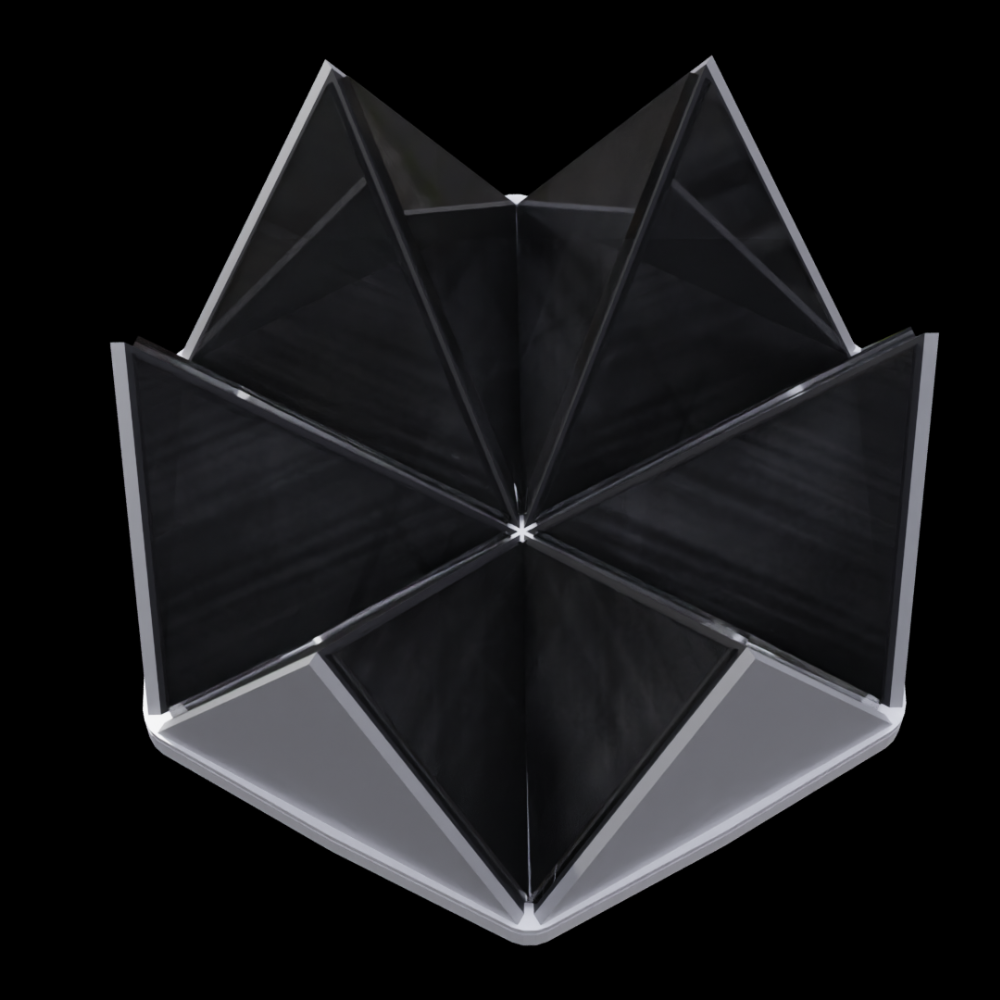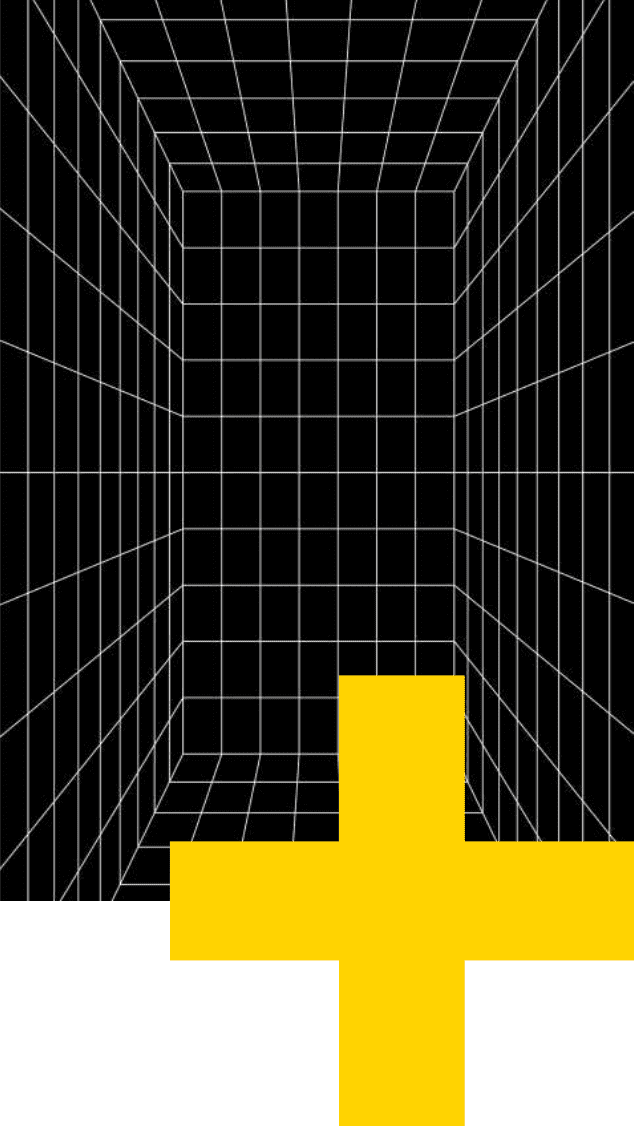SHAVAS panel
A major development in the photovoltaic sector capable of multiplying electricity production by 3.5 times for the same ground surface.

PHOTOVOLTAIC INDUSTRY
The current situation
In the field of photovoltaic solar energy, solar panels are generally used in which the active material is arranged in the x/y plane (2 dimensions) with a single orientation.
The amount of electricity produced is directly related to the sun’s evolution. Production is at its highest when the sun is at its peak, and achieves a general yield of between 7% and 25% per m2 in the best of cases, depending on a number of criteria, including the active material used. To maximise insolation throughout the year, the panels are oriented towards the position of the sun at the equinoxes, depending on their latitude.
Since the beginning of the history of photovoltaic panels, most of the research and development has focused on active materials and their assembly.
Our solution
A 3D solar panel with 6 times more photovoltaic material in the same area
The innovative technology of Shavas, with results certified by an independent laboratory and tested in real-life conditions, lies in its 3-dimensional design. Unlike traditional flat solar panels, the Shavas cell has active photovoltaic material on the X, Y and Z axes.
active photovoltaic material on the X, Y and Z axes. This 3D layout means that up to 6 times more active material can be concentrated for the same surface area occupied.
Result: Energy production is multiplied by 3.5 times!

Current technologies
Because the active ingredient is deposited flat in the x/y plane and is unidirectionally oriented, existing technologies have a number of shortcomings.
- Low yield per m2.
- Annual loss of maximum panel power as a function of the height of the sun in the sky.
- Poor performance in diffuse light (cloudy skies, etc).
- Irregular energy production, with significant losses at the beginning and end of the day as the sun rises and falls.

SHAVAS technology
SHAVAS technology uses three-dimensionality to optimise the concentration of the active ingredient compared with a flat surface, while maximising the yield for an equivalent surface area.
- Power per m2 multiplied by an average of 3.5.
- Layout of the active ingredient in 3 dimensions x, y and z
- Multi-directional arrangement of the active ingredient in 12 complementary vectors.
- Coefficient of area of 6 between x, y (area on the ground) and x, y, z (area developed in the volume of the cell in 3D).
- Efficient energy restitution with a SHAVAS module in a vertical position.
- Production of electricity earlier each morning and later each evening.
THE SHAVAS CELL
Description
The SHAVAS cell uses three-dimensionality to concentrate the active material on the same flat surface. This three-dimensionality is organised in such a way that the photovoltaic active material presents a maximum surface area to insolation, whatever the position of the light source.
The spiky layout was chosen to minimise the generation of cast shadows, while still allowing good light penetration into the system.
The multi-vector reception of luminosity means that the energy produced is more regular, breaking the Gaussian curve phenomenon typical of existing photovoltaic panels.

Patented technology
Protected by 4 international patents
THE SHAVAS CELL
Structure
Structurally, the SHAVAS cell will take the form of a hexagonal block.
It can remain a single, modular unit or be pre-engineered in the shape and size of a conventional panel as part of a replacement for an existing installation.

Base
A base containing all the internal electrical wiring
Support & Active material
A multidirectional support structure with active photovoltaic material
Filling
A crystalline solid fills the Shavas cell
Coating
Anti-reflective coating
THE SHAVAS PANEL
How it works
The SHAVAS three-dimensional cell captures solar radiation
solar radiation in the most efficient way, regardless of
position of the sun, without any additional mechanism
mechanisms (tracking, etc.). In addition, the active material
in multiple directions and therefore always
always advantageously exposed to the sun provides a more regular supply of energy whatever the duration of exposure.
With an active surface area that is greater than the flat surface area, the SHAVAS panel produces significantly more energy. With more active surface area per m2 and more orientation vectors, SHAVAS captures more solar radiation in diffuse and indirect light over a longer period of the day, making use of times that were not possible with conventional panels.
Combined, these different characteristics of SHAVAS result in a yield per m2 that is around 3.5 times greater than that of a conventional panel using the same active material.
Find out more
Contact us
If you are interested in our technology or would like to find out more, fill in the form below and we will ge back to you as soon as possible.
Current technology
By laying the active material flat in the x/y plane and orienting it unidirectionally, the existing technologies lead to the following defects:
- Low yield per m2.
- Low efficiency in diffused light (cloudy skies, etc.)
- Annual loss of maximum panel power depending on the height of the sun in the sky.
- Irregular energy production with high losses at the beginning and at the end of the day when the sun is rising and falling.
For these reasons, the installation of solar panels requires optimisation of the installation in terms of tilt and orientation to get closer to ideal conditions, which is not always the case on existing buildings.

our innovation
The Shavas panel
We therefore created Shavas which is a photovoltaic cell with :
- An arrangement of the active material in 3 dimensions x, y and z.
- A multidirectional arrangement of the active material of 12 complementary vectors.
- A surface coefficient of 6 between x, y (ground surface) and x, y, z (developed surface in the 3D cell volume).
- The increase of the developed surface covered with active material results in a multiplication of the power per m2 on average of 200% (or 120% depending on the latitude or the season) for a one day to one year time span (with an identical active material).
- Efficient energy restitution with a Shavas module in a vertical position.
Create an architectural design to allow the maximum amount of PV surface to be installed in the least amount of floor space possible while maximising the yield per unit area".
Description
The Shavas cell uses three-dimensionality to concentrate active material on the same flat surface. This threedimensionality is organised in such a way that the active photovoltaic material presents a maximum surface to the insolation, whatever the position of the light source. Its spiky arrangement (bristle shape) was chosen for the low generation of shadows while still allowing easy light penetration within the system.
The multi-vectorisation of the light reception allows a greater regularity of the energy produced, breaking the phenomenon of the Gaussian curve specific to existing photovoltaic panels. Structurally, the Shavas cell will take the form of a hexagonal block composed as follows, from base to top :
• A sub-base containing all of the system’s internal electrical wiring and showing the external connection of the operating polarities
• A multidirectional support structure
• The active photovoltaic material*.
• A filling of the Shavas cell with a solid crystalline material
• An anti-reflection coating
• The cell can remain single and modular or pre-engineered in the shape and size of a conventional panel as part of a replacement for an existing installation.

But then how does it work ?
The three-dimensional Shavas cell is composed of 6 vertices offering 12 faces, each with a different and complementary orientation, allowing it to capture the sun’s rays in the most efficient way, regardless of the sun’s position, without any additional mechanism (tracking, etc.). On the other hand, the active material arranged in multiple directions and therefore always advantageously exposed to the sun provides a more regular supply of energy whatever the duration of exposure.
With a larger active surface area than the flat surface, the Shavas panel provides a significantly higher energy output. With more active surface area per m2 and more orientation vectors, Shavas captures more diffuse and indirect solar radiation for a longer period of time during the day, making it possible to exploit moments that were not possible with conventional panels. Combined, these different characteristics of the Shavas result in a yield per m2 that is at least twice as high as that of the same conventional panel using the same active material.
Tandem cells
Shavas, the technology capable of adapting to the most promising innovations to come
New photovoltaic cells (Tandem) will soon be available on the market.
Scientists from EPFL’s Laboratory of Photovoltaics and Thin Film Electronics (PV-lab), led by Christophe Ballif, developed a method to distribute perovskite layers evenly over textured silicon in 2018. The devices developed to demonstrate the feasibility of the concept succeed in achieving an efficiency of 25.2%.
The researchers have now improved the perovskite crystallisation process and developed ultra-transparent layers resulting in tandem solar cells with an efficiency of 29.2% on a 1 cm2 surface. This efficiency has been certified by the independent Fraunhofer Institute for Solar Energy Systems (Fraunhofer ISE) in Germany, which represents a new world record for a fully textured silicon-perovskite device.
The Shavas photovoltaic panels will keep their technological advances by also benefiting from the performance of the Tandem cells. These new generation cells will also fit on the Shavas modules.
